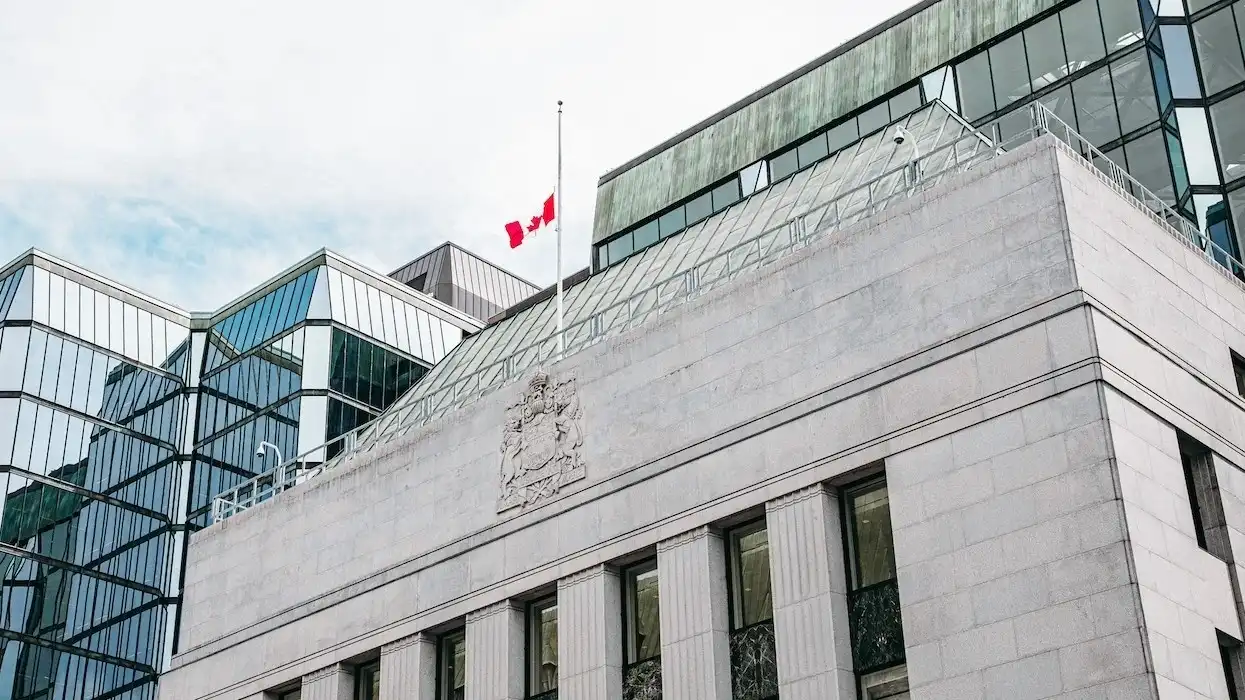Governing Council was out for August, but tomorrow — on Wednesday, September 4 — they’ll be back for the third-last interest rate announcement of the year. And for once, economists with the country’s ‘Big Five’ banks seem to be on the same page, agreeing not only that the Bank of Canada will opt for a cut, but on how many basis points that cut will be.
However, there is some diversity in views when it comes to subsequent announcements, including those scheduled for October 23 and December 11.
Based on BoC Governor Tiff Macklem’s dovish tone at the last meeting in July — where he expressed that there is now “more excess supply in the economy” and “downside risks are taking on increased weight” in monetary policy deliberations — and multiple sets of data releases on inflation, the labour market, and GDP, here’s what the experts are forecasting.
TD: “Slated to keep cutting at every meeting”
We capped off last week with new data from Statistics Canada on Gross Domestic Product, which showed that the economy grew 2.1% in the second quarter (compared to the quarter earlier). This figure was “ahead of expectations,” said TD Economist Maria Solovieva in a note from Friday, but was mainly influenced by government expenditures and purchases of goods and services — and not enough to derail a BoC cut.
Solovieva points out that household spending was “lower than expected” and was consistent with recent data on retail sales, which similarly pointed to “a weaker trajectory.” Also of note: spending on residential investment saw its more significant fall in over a year with all major components, including construction, renovations, and homeownership transfer costs, declining during the quarter. “We expect growth to continue at a below-trend pace for the next several quarters until the economy gains further relief from lower rates,” Solovieva wrote.
Later she said that the BoC is “likely to interpret this week’s data as supportive of maintaining its easing bias,” and that “with the [US Federal Reserve] now poised to adopt a similar policy stance, the risk of significant monetary policy divergence has diminished, reducing downward pressure on the Canadian dollar and easing the risk of importing price inflation.”
In an earlier publication from TD, Economists Beata Caranci and James Orlando look at the bigger picture, saying that “the pattern of a 25 basis points per meeting has been established” after the events of June and July, and that the current policy rate is 125 to 225 basis points above what they think the economy warrants amid slackened inflation. “This means that the BoC, like the Fed, is slated to keep cutting at every meeting, bringing the policy rate to 3.75% by year-end and 2.5% by end-2025.”
RBC: ‘The hurdle for more rate cuts is low’
In response to the latest data on GDP, RBC Economist Abbey Xu wrote in a commentary that it has come in soft enough to signal to the BoC that inflation will continue on a downward trajectory. As such, RBC’s expectation is that tomorrow’s interest rate announcement will culminate into 25-basis-point cut, bringing the policy rate down to 4.25%.
The forecast was echoed in another publication from RBC’s Nathan Janzen and Claire Fan, who added that Governor Macklem’s comments tomorrow will “likely again err on the dovish side, continuing to emphasize a softening economic backdrop that makes it more likely that inflation will keep trending lower.”
In addition Janzen and Fan’s report pointed to the unemployment rate — it’s up close to a percentage point from a year ago — as another important economic indicator, alongside CPI and GDP. RBC’s expectation on that front is the GDP will increase again in August to 6.6%.
“Governor Macklem reinforced after the last rate cut in July that the central bank is convinced inflation will continue to drift lower even if ‘there could be setbacks along the way,’ but July CPI data also surprised on the downside,” they said. “Moving forward, the hurdle for more BoC rate cuts from what are still-elevated levels is low. Our own base-case assumes another 150 basis points of cuts (including the expected September reduction) by mid-2025.”
Scotiabank: “Widely expected and more than fully priced”
Scotiabank Economist Derek Holt wrote in an economic publication from Friday that a quarter-point rate cut tomorrow is “widely expected and more than fully priced.” And the same goes for the October and December meetings, according to economists with the bank. “If delivered, this would take cumulative easing to -125 basis points from a 5% policy rate peak to 3.75% by year-end.”
There are of course risks to that forecast, including “the course of data and market developments, possibly the contents of the Federal government’s Fall fiscal update some time in November or December that may include election year goodies, plus US election aftermath,” Holt said. “To paraphrase former Governor Poloz when he skipped between two cuts in early 2015, policy adjustments do not have to go in a straight-line and there is merit to keeping some powder dry.”
In terms of market pricing, Holt pointed to a forecast from OIS markets, which has the policy rate down to 3% by next summer. “In short, the Canadian rates curve is significantly priced for perfection in the delivery of aggressive rate cuts. What could add to this pricing would be bigger and sooner cuts compared to the 25 basis points per meeting pace that is roughly priced,” he said, later adding that, in his view, the BoC is “not out of the woods” when it comes to inflation and should (continue to) cut with caution.
“Immigration remains wildly excessive. Housing shortfalls that existed before the pandemic have grown more acute and are likely to remain that way throughout the decade and possibly beyond. Real wage growth is accelerating while productivity continues to tank,” Holt wrote. “Fiscal policy is still adding to GDP growth and it’s reasonable to think there will be more stimulus applied into an election year given the Federal government’s poor polling. The potential combination of monetary and fiscal easing feeding off one another may well reignite inflation risk.”
CIBC: “A taste for moving 25 basis points at a time”
On tomorrow’s rate announcement, CIBC Economist Avery Shenfeld has pointed out that the BoC will be making its decision before the US Federal Reserve makes its announcement next week. Speaking to the Feds, the expectation is for Chairman Jerome Powell to unveil the first cut of the cycle, with a 50 basis points cut not out of the question amid slack in the labour market and Powell’s dovish tone in recent months.
“But Canada isn’t a US copycat when it comes to its rate decisions, and having already provided 50 bps of relief before any Fed move, it’s clearly not following the US lead. If past is prologue, it seems to have a taste for moving 25 basis points at a time, so that’s also our forecast,” Shenfeld said.
Shenfeld also underscored that the September rate announcement is just a few days shy of the release of new job data, which isn’t ideal for the BoC’s purposes, but shouldn’t give Governing Council too much pause. “We’ve already seen enough of a drop in Canadian inflation, and sufficient labour market weakness, to make another rate cut a forgone conclusion, and not that dependent on one jobs number,” he said.
“CPI has run below 2% over the past year excluding the one item, mortgage interest, that gets pushed lower as the BoC cuts rate. As for the labour market, there’s a myth that only recent immigrants have felt any deterioration in their prospects. That ignores the steep decline in overall job vacancies in the past year. True, the newly-arrived have experienced a larger percentage point climb in their unemployment rate. But because they are a modest part of the overall workforce, their contribution to the overall climb in the jobless rate has been smaller than that of the Canadian-born or immigrants who came more than five years ago.”
BMO: “Potentially more aggressive cuts later this year”
Over at BMO, the forecast is with the majority, with economists with the bank anticipating a quarter-point cut to come out of tomorrow’s meeting. “However, if Q3 [GDP] comes in far below the BoC's forecast and the jobless rate continues to forge higher (August data out next Friday), that could open the door to potentially more aggressive cuts later this year — especially if the Fed is also tilting that way in the fall,” wrote BMO Economist Douglas Porter in a note.
In a separate commentary published the same day, Porter, like Shenfeld, underlined the role of the US Federal Reserve in the BoC’s future moves, going as far as to say “the biggest factor driving a potentially more aggressive series of rate cuts is the changed outlook for the Fed” (as much as it would “pain” the BoC to admit).
“With markets back to pricing in a series of early and often US rate cuts — frankly egged on by Chair Powell — this has helped firm the Canadian dollar, thus removing one remaining hurdle for the Bank. We are maintaining our call of 100 basis points of cuts by January, and then another 50 bps by mid-2025, taking the overnight rate to 3% by next June,” Porter said. “But the risk is clearly that the Bank moves even sooner, and possibly more. After all, if the jobless rate keeps rising, and the output gap keeps widening, while inflation is better behaved, why would the Bank stop at 3%? That’s our Wonder Wall.”
Secure A Second Opinion On Your Mortgage Below:
______________________________________________________________________________________________________________________________
- Easing Does It: Bank Of Canada Lowers Interest Rate By Another 0.25% ›
- Where Every Big Bank Stands On Tomorrow's Interest Rate Announcement ›
- Bank Of Canada Lowers Interest Rate By Another 0.25% ›
- Every Big Bank On October's Interest Rate Announcement ›





















